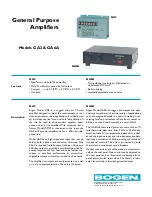
APPENDIX B
B - 1
NOISE SOURCES AND CURES
Noise, random and uncorrelated fluctuations
of electronic signals, finds its way into
experiments in a variety of ways. Good
laboratory practice can reduce noise
sources to a manageable level, and the
lock-in technique can be used to recover
signals, which may still be buried in noise.
Intrinsic Noise Sources
Johnson Noise
Arising from fluctuations of electron density
in a resistor at finite temperature, these
fluctuations give rise to a mean square
noise voltage,
_
V
2
=
∫
4kT Re [Z(f)]df = 4 kTR
∆
f
where k = Boltzmann’s constant,
1.38 x 10
–23
J/°K; T is the absolute
temperature in Kelvin; the real part of the
impedance, Re[z(f)] is the resistance R; and
we are looking at the noise source with a
detector, or AC voltmeter, with a bandwidth
of
∆
f in Hz. For a 1 M
Ω
resistor:
_
(V
2
)
1/2
= 0.13
µ
V/
√
Hz
To obtain the rms noise voltage that you
would see across this 1M
Ω
resistor, we
multiply 0.3
µ
V/
√
Hz by the square root of
the detector bandwidth. If, for example, we
were looking at all frequencies between DC
and 1 MHz, we would expect to see a rms
Johnson noise of:
_
(V
2
)
1/2
= 0.13
µ
V/
√
Hz * (10
6
Hz)
1/2
= 130
µ
V
‘1/
f
Noise’
Arising from resistance fluctuations in a
current carrying resistor, the mean squared
noise voltage due to ‘1/
f
‘noise is given by,
_
V
2
= AR
2
I
2
∆
f/f
where A is a dimensionless constant, 10
-11
for carbon, R is the resistance, I the current,
the bandwidth of our detector, and f is the
frequency to which the detector is tuned.
For a carbon resistor carrying 10 mA with
R = 1 k,
∆
f = f = 1 Hz, we have:
V
noise
= 3
µ
Vrms
Others
Other noise sources include flicker noise
found in vacuum tubes, and generation and
recombination noise found in
semiconductors.
All of these noise sources are incoherent.
Thus, the total noise is the square root of
the sum of the squares of all the incoherent
noise sources.
Non-Essential Noise Sources
In addition to the “intrinsic” noise sources
listed above there are a variety of “non-
essential” noise sources, (i.e. those noise
sources which can be minimized with good
laboratory practice). It is worthwhile to look
at what might be a typical noise spectrum
encountered in the laboratory environment:
Noise Spectrum
Some of the non-essential noise sources
appear in this spectrum as spikes on the
intrinsic background. There are several
Содержание SR560
Страница 2: ......
Страница 8: ...4...
Страница 10: ...SPECIFICATIONS 6...
Страница 26: ...APPENDIX A A 2...
Страница 30: ...APPENDIX B B 4...
Страница 44: ...SR560 COMPONENT PARTS LIST C 14...
















































